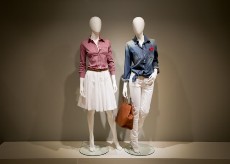
Bergdorf Goodman has been a staple of New York shopping since well before it moved to its 5th Ave. location in 1928, but it was only about 14 years ago that, under the direction of design geniuses Linda Fargo and David Hoey, Bergdorf’s became a marketer’s mecca, as well.
Every season, the monumental department store dramatically reveals intricately planned window displays that impress and entice shoppers walking along 5th Avenue. The displays are loud and exciting, depicting fanciful scenes of paper cities and brass zoos constructed delicately by a team of devoted artists. The windows are often chaotic and seem scarcely related to Bergdorf’s main product of high fashion clothing — yet the displays manage to move more merchandise than most shops dream of selling in 10 years.
Not every store can be Bergdorf Goodman, but every store does have the ability to construct displays with just as much power to make sales. Read on for a quick guide to transforming your retail space into a profitable machine with the simple act of making memorable displays.
Select a Theme and Tell a Story
Just as your advertising strategy should form a cohesive premise, all the displays in your store should be interconnected with a common theme. The theme of the season is an easy jumping-off point for most stores, but be wary of assembling a massive Valentine’s display out of every pink and red item in your store. Instead, once you have a theme in mind — Valentine’s Day, for instance — try to weave a story using props and merchandise. Hardware stores may provide suggestions for mending a broken heart with nails, glue, hinges, and more; grocery stores can assemble recipes and ingredients for romantic Valentine’s meals; clothing stores can position mannequins like couples going on their Valentine’s dates.
For example, this past holiday season, Bergdorf Goodman created holiday-themed window displays based on a single word: inspired. Each window was a tribute to a different form of art — literature, architecture, music, etc. However, each window also stayed within the greater theme of the winter holidays.
Assemble a Tool Kit
When it comes to winning displays, precision is key. While you might turn some heads with a sloppy design, you likely won’t garner any additional revenue from your efforts. That’s why you absolutely must bring your story to life with a proper set of tools to measure, cut, and construct the exact display you have in mind. Here’s what you need:
- Pen and paper
- Tape measure
- Scissors
- Stapler or double-sided tape
- Hammer and nails or screwdriver and screws
- Glue gun
- Props, including merchandise and non-merchandise items
Bergdorf Goodman employs a team of artists, carpenters, electricians, and more, but most shops don’t need more than what is mentioned above to create a fascinating display. You can even save yourself the process of more intensive construction by repurposing regular store fixtures like gondola shelving into something spectacular.
Be Bold, but Keep It Simple
Most people can barely spare a second on distractions like window displays, so you need to grab potential shoppers’ attention quickly and efficiently with big, bold design. Use color in daring ways — instead of regular red, explore fuchsia — and find or make unusual props to incorporate into your displays. Papier-mâché and foam board crafts are cheap, easy, and fun to make, and they can serve as distinct visual elements in your design.
However, novices in the world of design can easily become carried away with different options for their displays, and many end up using every idea at once and creating an overwhelming jumble rather than a memorable masterpiece. You should avoid cluttering your displays with too many props or pieces of merchandise. Plus, while you experiment with going big and paring down, be sure you stay true to the messages of your brand. Bergdorf Goodman includes crazy elements like giant polar bears and prancing carousel horses to highlight the avant-garde nature of the store, but they always make the clothing and accessories the focal point of the piece to remind shoppers what they are truly selling. You should do the same with your displays.
Step Back and Observe
Once the process is complete — you’ve brainstormed, designed, and built your show-stopping display — it is important to look at your project before revealing it to the world. You should approach the display from different angles, looking for flaws. You can use this final review to spot problems with your design, but more likely — just as David Hoey does on the day of Bergdorf’s big reveal — you can bask in the pleasure of a display well-made.






